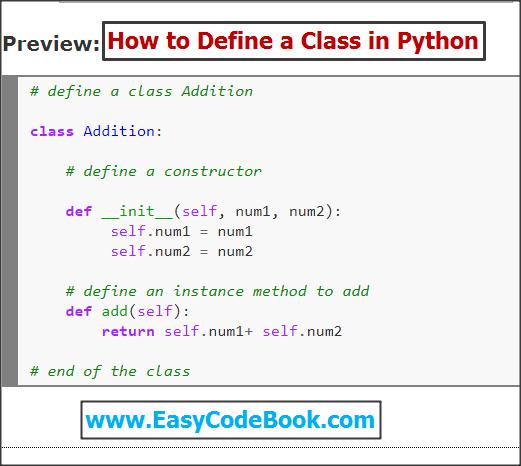Topic: Python Class and Objects With Code Examples
How to create Class and Objects in Python
What is a class in Python?
A class is the specification of a set of objects of the same type. A class is a template or design plan to create objects of the same type.
A class is a template for objects. It contains the code for all the object’s methods.
Normally we will use a special method with name __init__() called constructor. The constructor will initialize the instance variables of the object automatically at the time of object creation.

Example of a class
Suppose we are to create a class to provide the functionality to add two numbers. It contains:
- Two instance variables, num1, num2
- One Constructor
- One method add() to return the sum of two numbers.
Writing a class in Python
Now we name this class as “Addition”. The first letter of each word is capital for a class name.
We will use two instance variables num1, num2.
We define a parameterized constructor to initialize the num1, num2 by the given values.
Note: The first argument in an instance method is a special variable called ‘self’. ‘self’ represents the current object upon which this method is called.
A method add() will return the addition of num1 and num2.
How to Define a Class in Python?
We define a class in Python using “class” keyword. We will define, in class:
- instance variable
- constructor
- methods
Python Class Example
# define a class Addition class Addition: # define a constructor def __init__(self, num1, num2): self.num1 = num1 self.num2 = num2 # define an instance method to add def add(self): return self.num1+ self.num2 # end of the class
What is a Constructor in Python?
A constructor is a special method with the name __init__ . The underscores indicate that it is a special kind of method. It is called a constructor, and it is automatically called when we create
a new object from a class. The constructor is usually used to initialize the instance variables of the object being created. This constructor is automatically called whenever a new object of this class is created.
How to define a constructor in Python?
Syntax:
def __init__(self, arg1, arg2,...):
self.var1 = arg1
self.var2 = arg2
...
Example of Constructor in Python Class:
def __init__(self, num1, num2):
self.num1 = num1
self.num2 = num2
What is an object in Python?
An object is an instance of the class. An object of the class will contain its separate instance variables. The instance methods of the class will act upon the instance variables to process data of the object.
How to Create an Object in Python?
The basic syntax to create an object is:
object_name = Class(arg1,arg2,…)
Python create instance of class
Example Of Creating an Object in Python
Let us create an object aobject1 of Addition class:
object1 = Addition(10,20)
When above statement is executed, a new object of Addition class is created. This will call the constructor automatically with arguments 10 and 20. Hence a new object is created with values of num1=10 and num2=20. The object1 variable will have the reference to the new object.
How to Create an Instance Method in Class?
An instance method is a method defined in a class in Python to perform some action on object data – instance variables.
Syntax:
def method_name(self):
statement1
statement2
...
Example:
def add(self):
return self.num1 + self.num2
Note: self is a special variable representingthe current object.
Always use self.instancc_variable when accessing instance variables.
How To Call an Instance Method
We will use dot notation to call an instance method.
object.method( )
And if this method returns some value then
variable = object.method( )
Example:
sum = object1.add( )
Complete Example Program Using class and Objects
# Python program to define a class Addition # with two instance variables num1, num2 # one constructor # one method add() # define class named Addition class Addition: # define constructor def __init__(self, num1, num2): self.num1 = num1 self.num2 = num2 # define add() instance method def add(self): return self.num1 + self.num2 # create an instance that is object of class Addition obj1 = Addition(80, 20) # call add method with obj1 object sum = obj1.add() print("Sum =", sum)
Output: Sum = 100
Related Posts on Python OOP concepts
- Python Create New Class Rectangle
- Python Circle Class With Getter Setter Methods
- Creating a Math1 class to add two numbers in Python
- Python Circle Class With Getter Setter Methods
- Python Create New Class Rectangle
- Python Class and Objects With Code Examples
- Create New Java Class Calculation Add Subtract
- Creating New Box class in Java
- Define Bar Chart Class in Java Program
- Define Circle Class in Java with Radius and Area
- Create a New Java Class Rectangle – Java Program
- Design and Use Triangle Class – C++ Program
- C++ Program Temperature Conversion Using Class and Objects
![]()
I usually do not leave comments on article. It appears foolish to do so. I desired to take a moment to tell you that I discovered your message to be worthwhile of recommendation. The quantity of info that you consisted of in it is absolutely outstanding as well as it is nice to see that another person is as interested in this subject as I am. Cherida Andrea Heintz
Pingback: Python Circle Class With Getter Setter Methods | EasyCodeBook.com